Related Research Articles
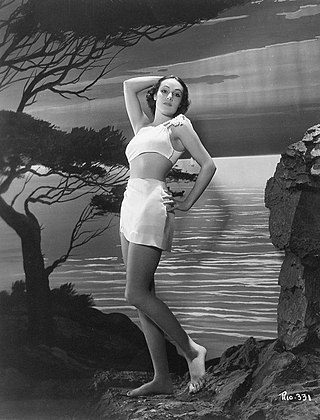
A bikini is a two-piece swimsuit primarily worn by girls and women that features one piece on top that covers the breasts, and a second piece on the bottom: the front covering the pelvis but usually exposing the navel, and the back generally covering the intergluteal cleft and a little, some, or all of the buttocks. The size of the top and bottom can vary, from bikinis that offer full coverage of the breasts, pelvis, and buttocks, to more revealing designs with a thong or G-string bottom that covers only the mons pubis, but exposes the buttocks, and a top that covers only the areolae. Bikini bottoms covering about half the buttocks may be described as "Brazilian-cut".

A swimsuit is an item of clothing designed to be worn by people engaging in a water-based activity or water sports, such as swimming, diving and surfing, or sun-orientated activities, such as sun bathing. Different types may be worn by men, women, and children. A swimsuit can be described by various names, some of which are used only in particular locations or for particular types of suit, including swimwear, bathing suit, bathing attire, swimming costume, bathing costume, swimming suit, swimmers, swimming togs, bathers, cossie, or swimming trunks, besides others.

William Ralph Blass was an American fashion designer. He was the recipient of many fashion awards, including seven Coty Awards and the Fashion Institute of Technology's Lifetime Achievement Award (1999).
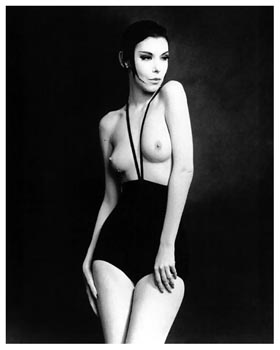
The monokini was designed by Rudi Gernreich in 1964, consisting of only a brief, close-fitting bottom and two thin straps; it was the first women's topless swimsuit. His revolutionary and controversial design included a bottom that "extended from the midriff to the upper thigh" and was "held up by shoestring laces that make a halter around the neck." Some credit Gernreich's design with initiating, or describe it as a symbol of, the sexual revolution.

The most characteristic North American fashion trend from the 1930s to 1945 was attention at the shoulder, with butterfly sleeves and banjo sleeves, and exaggerated shoulder pads for both men and women by the 1940s. The period also saw the first widespread use of man-made fibers, especially rayon for dresses and viscose for linings and lingerie, and synthetic nylon stockings. The zipper became widely used. These essentially U.S. developments were echoed, in varying degrees, in Britain and Europe. Suntans became fashionable in the early 1930s, along with travel to the resorts along the Mediterranean, in the Bahamas, and on the east coast of Florida where one can acquire a tan, leading to new categories of clothes: white dinner jackets for men and beach pajamas, halter tops, and bare midriffs for women.

History of fashion design refers specifically to the development of the purpose and intention behind garments, shoes, accessories, and their design and construction. The modern industry, based around firms or fashion houses run by individual designers, started in the 19th century with Charles Frederick Worth who, beginning in 1858, was the first designer to have his label sewn into the garments he created.

Melissa Ann Odabash MBE is an American fashion designer and former model based in London. She is known for her swimwear designs and has been noted by Vogue as creating the "Ferraris of swimwear." Odabash's designs have been worn by Beyoncé, Kate Moss, Sienna Miller, Rihanna, Gwyneth Paltrow, Rosie Huntington-Whiteley and the Princess of Wales.

Jacques Heim was a French fashion designer and costume designer for theater and film, and was a manufacturer of women's furs. From 1930 to his death in 1967, he ran the fashion house Jacques Heim, which closed in 1969. He was president of the Paris Chambre Syndicale de la haute couture from 1958 to 1962, a period of transition from haute couture to ready-to-wear clothing.

Many stylistic variations of the bikini have been created. A regular bikini is a two-piece swimsuit that together covers the wearer's crotch, buttocks, and breasts. Some bikini designs cover larger portions of the wearer's body while other designs provide minimal coverage. Topless variants are still sometimes considered bikinis, although they are technically not a two-piece swimsuit.

Evidence of bikini-style women's clothing has been found as early as 5600 BC, and the history of the bikini can be traced back to that era. Illustrations of women wearing bikini-like garments during competitive athletic events in the Roman era have been found in several locations, the most famous of which is at Villa Romana del Casale.

The thong is a garment generally used as either underwear or in some countries, as a swimsuit. It may also be worn for traditional ceremonies or competitions.
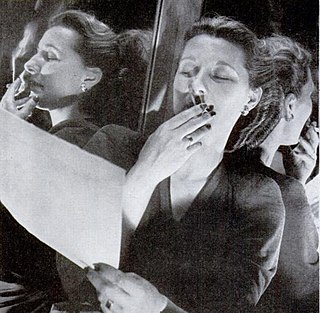
Clare Potter was a fashion designer who was born in Jersey City, New Jersey in 1903. In the 1930s she was one of the first American fashion designers to be promoted as an individual design talent. Working under her elided name Clarepotter, she has been credited as one of the inventors of American sportswear. Based in Manhattan, she continued designing through the 1940s and 1950s. Her clothes were renowned for being elegant, but easy-to-wear and relaxed, and for their distinctive use of colour. She founded a ready-to-wear fashion company in Manhattan named Timbertop in 1948, and in the 1960s she also established a wholesale company to manufacture fashions. Potter was one of the 17 women gathered together by Edna Woolman Chase, editor-in-chief of Vogue to form the Fashion Group International, Inc., in 1928.
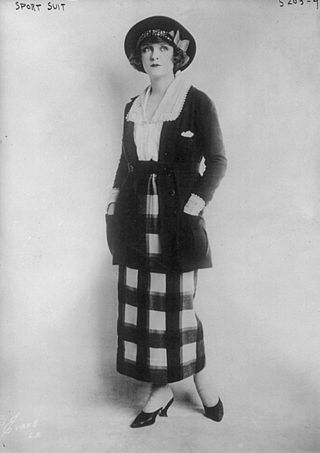
Sportswear is an American fashion term originally used to describe separates, but which since the 1930s has come to be applied to day and evening fashions of varying degrees of formality that demonstrate a specific relaxed approach to their design, while remaining appropriate for a wide range of social occasions. The term is not necessarily synonymous with activewear, clothing designed specifically for participants in sporting pursuits. Although sports clothing was available from European haute couture houses and "sporty" garments were increasingly worn as everyday or informal wear, the early American sportswear designers were associated with ready-to-wear manufacturers. While most fashions in America in the early 20th century were directly copied from, or influenced heavily by Paris, American sportswear became a home-grown exception to this rule, and could be described as the American Look. Sportswear was designed to be easy to look after, with accessible fastenings that enabled a modern emancipated woman to dress herself without a maid's assistance.

Anne Fogarty was an American fashion designer, active 1940–1980, who was noted for her understated, ladylike designs that were accessible to American women on a limited income. She started out as a model in New York in 1939, working for Harvey Berin on Seventh Avenue, before studying fashion design. She eventually secured a full-time design job in 1948, and became well-known for full-skirted designs with fitted bodices, inspired by Dior's New Look.
Zoran Ladicorbic, known as Zoran, is an American fashion designer who launched his business in 1976. He is particularly known for extremely minimalist, understated garments following the American sportswear principle, in neutral colors and high quality natural fabrics such as silk, linen and cashmere wool. His clothes have been described as "Gap for the very rich", and as "revolutionary" due to being designed without "built-in obsolescence".
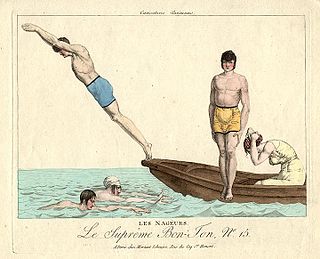
The history of swimwear traces the changes in the styles of men's and women's swimwear over time and between cultures, and touches on the social, religious and legal attitudes to swimming and swimwear.

Thomas Franklin Brigance was a Texan-born New York–based fashion designer noted for his work in sportswear in the 1930s, 1940s and 1950s. As a house designer for Lord & Taylor, Brigance was best known for bathing costumes and play clothes, and for his clever use of flattering details such as pleats and darts. During the 1930s Brigance was a rare example of a male working in the female-dominated world of American sportswear design. In the late 1930s, he was regularly mentioned alongside Clare Potter as a leading name in mid-range priced sportswear. Like Potter, Brigance was skilled at designing smart, fashionable clothing which could easily be mass-produced, making his work attractive to manufacturers as well as to customers.

Emily Wilkens was an American fashion designer specializing in children's wear. She won both the Neiman Marcus Fashion Award and the Coty Award for her work, which was considered groundbreaking for properly taking note of the requirements of teenage dressing, and not simply offering miniature grown-up garments. She was also an author, writing a number of books on self care and style, and during the late 1960s and early 1970s, became a beauty journalist, writing an advice column.

Adrienne Steckling-Coen (1934-2006), known as Adri, was an American fashion designer whose label, Adri, was particularly successful in the 1970s-1980s.
Jeanne S. Campbell (1919–2002) was an American fashion designer active from the 1940s to the 1970s. She was part of the American sportswear movement alongside Bonnie Cashin and Claire McCardell.
References
- 1 2 Whiteaker, Mildred (31 August 1975). "Fashion Fiesta". San Antonio Express-News.
- 1 2 3 Martin, Richard; Benbow-Pfalzgraf, Taryn (2002). Contemporary Fashion. St. James Press. p. 651. ISBN 978-1-55862-348-4.
- 1 2 3 4 5 6 Staff writer (8 August 1976). "Fashions to Show". Amarillo Sunday News Globe.
- ↑ "Henri Viterbo at MyHeritage.com". www.myheritage.com.
- ↑ Bianchini, Roger-Louis (1 November 2001). "Une affaire de familles". LExpress.fr (in French).
- ↑ Staff writer (1984). The New York Times Magazine. New York Times. p. 27.
- ↑ Staff writer (27 February 1957). "Briefer Bikini is Riviera Hit this Season". Racine Journal Times.
- 1 2 Noel, Lucie (19 July 1958). "Riviera Designers Make Own Laws for Sportswear". Winnipeg Free Press.
- ↑ de la Fontaine, Yvette (30 May 1968). "Summer Vacation Clothes ... French Riviera". Phoenix Arizona Republic.
- ↑ Adburgham, Alison (28 March 1972). "Ship shapes". The Guardian. (Original article here)
- ↑ Dauman, Deborah (12 September 1980). "Falls Sportswear - The Shape of Things To Come". DuBois Courier-Express. Copley News Service.